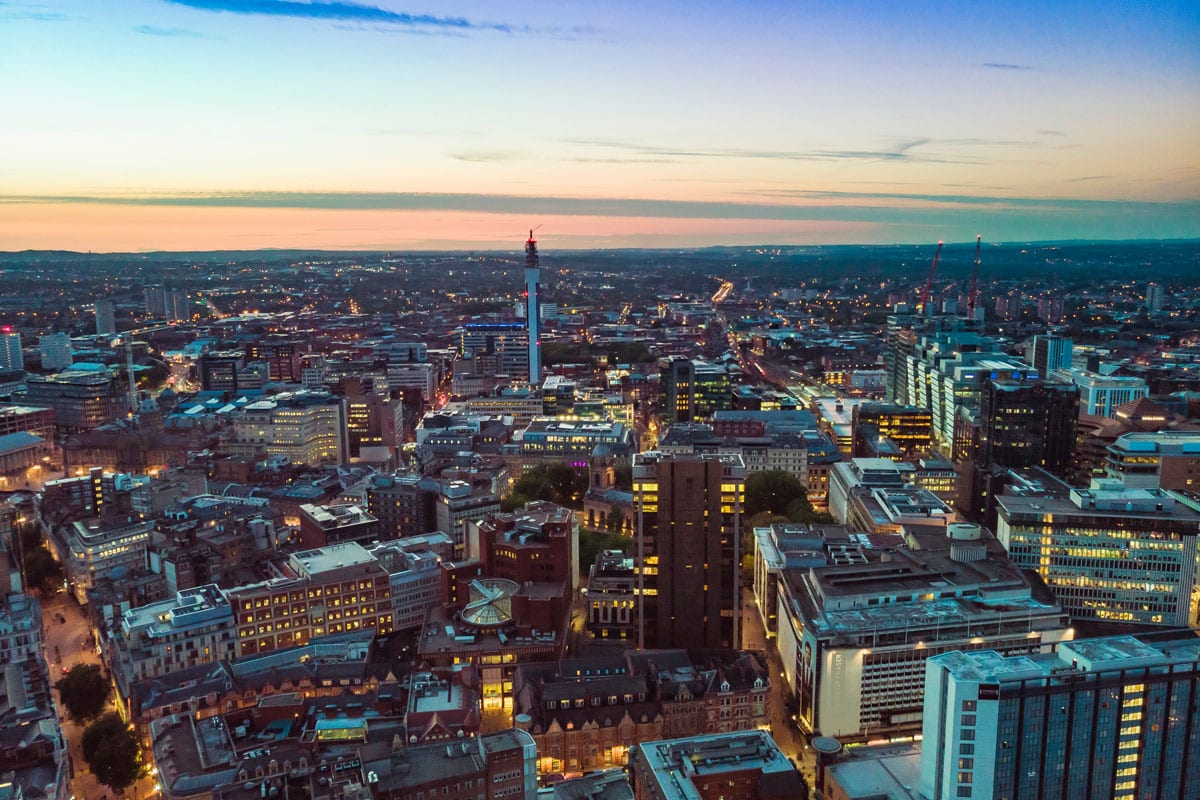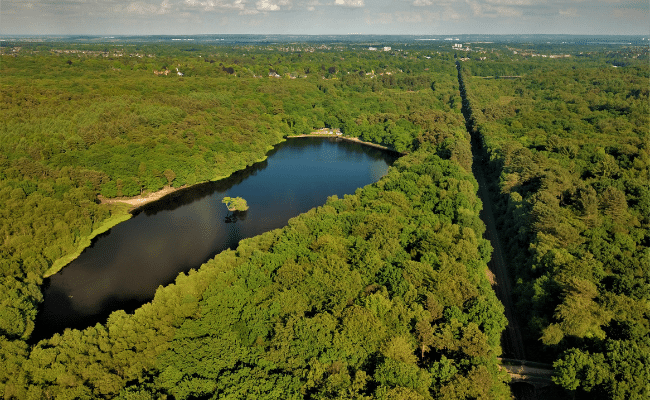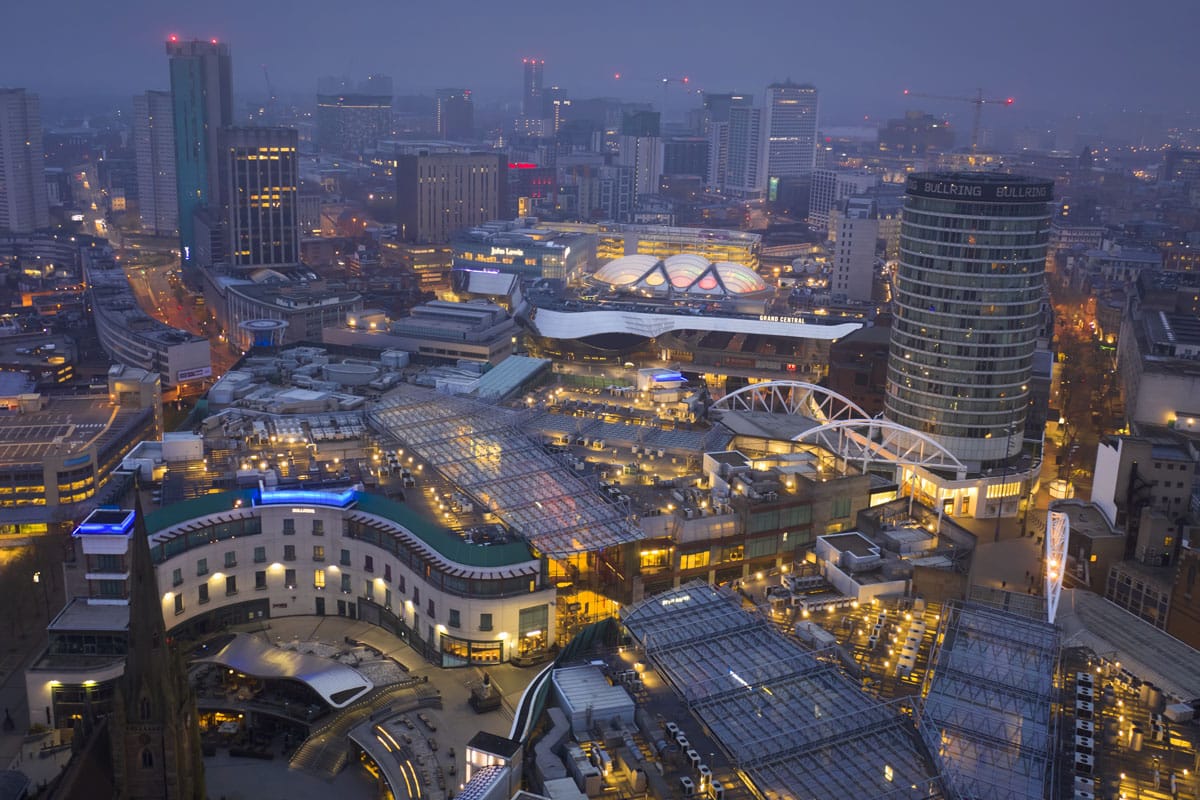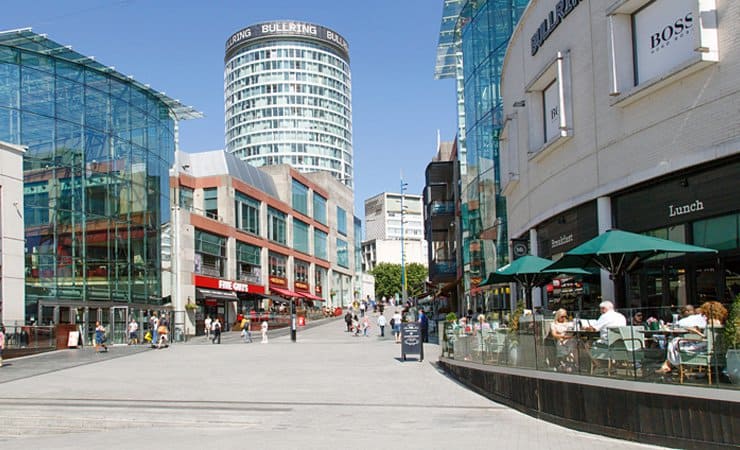Areas of Birmingham: Property Investment Buy-to-Let Hotspots
Birmingham is said to be England’s second city with a population of around 1.1 million and a fast-developing economy.
Property here costs well under half that of homes in London and they are even more affordable than homes in England's third largest city, Manchester, making it a very appealing option for investors and homeowners.
(Although Birmingham's most expensive streets hit an eye watering £3 million in average property prices).
Rental yields are impressive too for a major city, at 6.9%, and tenant demand is incredibly high with a lower than national average for homeownership, creating a lot of pressure on rental housing. This strong local demand is a key reason why buy-to-let investors look to Birmingham when they are aiming for a balance of housing capital growth, good rental yields and varied price ranges to suit all budgets.
In this article we look at exactly what postcodes in Birmingham show the most potential for landlords.
Data updated: January 2025. Next update: April 2025
Contents
- Best areas in Birmingham for property investment
- Why invest in Birmingham
- Average house prices in Birmingham (by property type)
- Detailed house price data for Birmingham
- Birmingham buy-to-let rental market analysis
- Is Birmingham rent high?
- Are house prices in Birmingham high?
- How much deposit do you need for the average property in Birmingham?
- Property and landlord licensing
- How to invest in buy-to-let's in Birmingham

-
by Robert Jones, Founder of Property Investments UK
With two decades in UK property, Rob has been investing in buy-to-let since 2005, and uses property data to develop tools for property market analysis.

Property Data Sources
Our location guide relies on diverse, authoritative datasets including:
- HM Land Registry UK House Price Index
- Ministry of Housing, Communities and Local Government
- Ordnance Survey Data Hub
- Propertydata.co.uk
We update our property data quarterly to ensure accuracy. Last update: January 2025. Next update: April 2025. All data is presented as provided by our sources without adjustments or amendments.
Best Areas in Birmingham for Property Investment
Birmingham's property market offers lots of options from high end luxury homes to affordable entry level housing for first time buyers and tenants. Throughout this article we look in depth at each of the key metrics that make up the Birmingham real estate market, and here we simplify it to look at the highlights for the major postcode districts across the city:
Average house prices £
- High end: Premium suburbs lead with the B94 postcode at £664,613 and next is B93 at £619,284
- Mid-range: Areas like B74 (Sutton Coldfield) average £486,178 and B91 (Solihull) at £468,992
- More affordable: Inner city areas like B2 (City Centre) at £179,311 and B6 (Aston) at £194,536 provide options without the hefty price tag.
Average cost of rents per week £
- High end: B7 ( including Nechells) commands £412 per week, while B93 (including Knowle) achieves £335. This is reflective of the larger homes in these postcodes and often include house of multiple occupation properties.
- Mid-range: B28 (including Hall Green) averages £308 per week, while B74 (Sutton Coldfield) averages £303 weekly rents.
- More affordable: B79 (Tamworth) averages £205 per week, while B70 (West Bromwich) shows £214
Average buy-to-let rental yields %:
- High yield: B18 (Jewelry Quarter) leads with 6.9%, followed by B15 (Edgbaston) at 6.8%
- Mid-range: B34 (Shard End) offers yields of 6.4% and B3 (City Centre) provides yields of 6.3%
- Lower yield: Premium suburbs like the B93 postcode district have a very low gross rental yield of only 2.8% due to the significantly higher purchase prices.

Why Invest in Birmingham?
Birmingham is the UK's second-largest city by population, with around 2,684,807 residents of the greater Birmingham area and around 1.1 million in the city itself.
The University of Birmingham has reached 93rd in the rankings of the top 100 Universities across the globe.
The city's economy has been boosted by major regeneration projects, including the £1.2 billion Paradise Redevelopment, Birmingham Smithfield with around 3,000 new homes being created and the Midlands Metro Extension which is a £1.3 billion investment to improve the tram network across the West Midlands.
Birmingham Airport's ambitions to grow it's international connections is a further tick in the box for international investors looking to visit the city and grow their buy-to-let investments locally.
Average house prices (£) in Birmingham
(by property type)
In October 2024, the latest house price index by the land registry (it is always a couple of months behind reporting it's datasets), shows the following average house prices across Birmingham:
Birmingham
- All property types - £240,232
- Flats and maisonettes - £163,934
- Terrace houses - £221,134
- Semi-detached houses - £274,500
- Detached houses - £444,511

Detailed House Price Data for Birmingham
When was the last house price crash in Birmingham?
The last significant property price crash in Birmingham occurred during the global financial crisis of 2008-2009, hitting prices of detached homes hard.
Since then, despite some fluctuations, the market has generally shown resilience and recovery with an upward trend to 2022.
2022 to 2024 however there has been another correction with apartments/maisonettes (flats) reducing in price.
This is whilst other 'affordable' housing types of terrace houses and semi-detached homes have continued to grow in value across the city, with average selling prices showing an upward trend for many years.
This could indicate a balancing of values, as there has been significant developments of luxury apartments across the city in recent years which may have lead to an over supply of high end apartments.
Highest house prices (£) in Birmingham
by postcode district (past 12 months)
| Rank | Area | Average House Price |
|---|---|---|
| 1 | B94 (Olton) | £664,613 |
| 2 | B93 (Knowle) | £619,284 |
| 3 | B48 (Alvechurch) | £536,250 |
| 4 | B95 (Henley-in-Arden) | £519,594 |
| 5 | B96 (Redditch) | £494,826 |
| 6 | B74 (Sutton Coldfield) | £486,178 |
| 7 | B72 (Sutton Coldfield) | £477,963 |
| 8 | B91 (Solihull) | £468,992 |
| 9 | B75 (Sutton Coldfield) | £431,105 |
| 10 | B47 (Hollywood) | £429,500 |
Lowest house prices (£) in Birmingham
by postcode district (past 12 months)
| Rank | Area | Average House Price |
|---|---|---|
| 1 | B2 (City Centre) | £179,311 |
| 2 | B6 (Aston) | £194,536 |
| 3 | B35 (Castle Vale) | £200,684 |
| 4 | B18 (Hockley) | £204,418 |
| 5 | B70 (West Bromwich) | £210,298 |
| 6 | B44 (Perry Barr) | £214,112 |
| 7 | B9 (Bordesley Green) | £214,336 |
| 8 | B66 (Smethwick) | £215,193 |
| 9 | B16 (Edgbaston) | £215,605 |
| 10 | B5 (Digbeth) | £216,103 |
Check out more property data on the 10 cheapest areas of Birmingham to buy a house or flat.
Highest house price growth (%) in Birmingham
| Rank | Area | 5-Year Price Growth |
|---|---|---|
| 1 | B96 (Redditch) | 51.4% |
| 2 | B7 (Nechells) | 48.2% |
| 3 | B19 (Lozells) | 45.6% |
| 4 | B10 (Small Heath) | 44.0% |
| 5 | B8 (Washwood Heath) | 40.7% |
| 6 | B65 (Rowley Regis) | 38.1% |
| 7 | B24 (Erdington) | 35.7% |
| 8 | B21 (Handsworth) | 35.5% |
| 9 | B33 (Kitts Green) | 35.4% |
| 10 | B71 (West Bromwich) | 34.9% |
The highest growth areas in Birmingham show substantial 5-year price increases, led by B96 postcode which includes Redditch at 51.4% and B7 postcode which includes Nechells at 48.2%. However, these figures should be viewed with some caution as they represent average prices across all property types - changes in the mix of properties being sold (such as more detached houses versus flats) can significantly impact these growth rates. Notably, many of the highest-performing areas are in traditionally more affordable parts of Birmingham, such as B10 which includes Small Heath and B8 postcode district which includes Washwood Heath, showing growth rates above 40%. This suggests a continued pattern of regeneration and increasing demand in previously undervalued areas. Current average prices in these high-growth areas remain relatively affordable by Birmingham standards, making them appealing to buy-to-let investors and homeowners.
Property Data Sources
Our location guide relies on diverse, authoritative datasets including:
- HM Land Registry UK House Price Index
- Ministry of Housing, Communities and Local Government
- Ordnance Survey Data Hub
- Propertydata.co.uk
We update our property data quarterly to ensure accuracy. Last update: January 2025. Next update: April 2025. All data is presented as provided by our sources without adjustments or amendments.
Birmingham Buy-to-Let Rental Market Analysis
The type of property in demand varies across Birmingham's districts. Apartments, particularly in central postcodes like B1 and B3, are sought after by young professionals and students, especially those studying at Aston University and Birmingham City University. The Jewellery Quarter (B18) and Edgbaston (B15) attract a mix of tenants drawn to their vibrant urban lifestyle, cultural amenities, and transport connections.
Meanwhile, single-family homes in areas like Sutton Coldfield (B72-B76) and Solihull postcodes (B90-B94) are popular with families and professionals seeking more space, good schools, and suburban living while maintaining easy access to the city centre.
Highest average rental per week (£) in Birmingham
by postcode district
| Rank | Area | Average Weekly Rent |
|---|---|---|
| 1 | B7 (Nechells) | £412 |
| 2 | B93 (Knowle, Dorridge) | £335 |
| 3 | B28 (Hall Green) | £308 |
| 4 | B74 (Sutton Coldfield) | £303 |
| 5 | B91 (Solihull) | £302 |
| 6 | B92 (Solihull) | £300 |
| 7 | B15 (Edgbaston) | £297 |
| 8 | B29 (Selly Oak) | £294 |
| 9 | B17 (Harborne) | £292 |
| 10 | B36 (Castle Bromwich) | £291 |
The highest rental prices in Birmingham show a diverse mix of inner-city, student areas, and affluent suburbs, with B7 (including Nechells) commanding the highest average at £412 per week, followed by the prestigious B93 (including Knowle and Dorridge areas) at £335. However, these figures should be viewed with some caution as they represent average rents across all property types - particularly in areas like Nechells where Houses in Multiple Occupation (HMOs) can significantly influence the averages due to multiple tenants. The presence of affluent suburbs in the rankings is notable, with Solihull postcodes (B91, B92) and Sutton Coldfield (B74) featuring prominently, reflecting the demand for high-quality family homes. Student-friendly areas like Selly Oak (B29) and professional hotspots such as Edgbaston (B15) and Harborne (B17) also command premium rents, driven by their proximity to the University of Birmingham, good transport links, and popular amenities.
Lowest average rental per week (£) in Birmingham
by postcode district
| Rank | Area | Average Weekly Rent |
|---|---|---|
| 1 | B79 (Tamworth) | £205 |
| 2 | B70 (West Bromwich) | £214 |
| 3 | B97 (Redditch) | £214 |
| 4 | B61 (Bromsgrove) | £221 |
| 5 | B98 (Redditch) | £225 |
| 6 | B63 (Halesowen) | £226 |
| 7 | B65 (Rowley Regis) | £227 |
| 8 | B66 (Smethwick) | £228 |
| 9 | B33 (Kitts Green) | £235 |
| 10 | B16 (Ladywood) | £236 |
The most affordable rental areas in Birmingham are predominantly found in the outer regions and satellite towns, with B79 (including Tamworth) showing the lowest average at £205 per week, followed by B70 postcode district (West Bromwich) and B97 (Redditch) both at £214. While these areas offer more affordable housing options, they also present interesting investment opportunities, with several locations showing attractive yields - notably B33 (Kitts Green) and B16 (Ladywood) both achieving yields of 5.7%. The presence of areas like the postcodes of B66 (Smethwick) and B65 (Rowley Regis) in the rankings reflects the availability of more affordable rental stock in Birmingham's traditional industrial areas, many of which are now experiencing regeneration.

Highest rental gross yield (%) in Birmingham
| Rank | Area | Average Yield |
|---|---|---|
| 1 | B18 (Hockley, Jewelry Quarter) | 6.9% |
| 2 | B15 (Edgbaston) | 6.8% |
| 3 | B34 (Shard End) | 6.4% |
| 4 | B3 (City Centre) | 6.3% |
| 5 | B1 (City Centre) | 6.2% |
| 6 | B5 (Digbeth) | 6.2% |
| 7 | B44 (Perry Barr) | 6.1% |
| 8 | B11 (Sparkhill) | 6.0% |
| 9 | B23 (Erdington) | 5.8% |
| 10 | B42 (Perry Barr) | 5.8% |
The highest rental yields in Birmingham are concentrated in areas combining relatively affordable purchase prices with strong rental demand. The Jewelry Quarter and Hockley (B18) leads with a 6.9% yield, followed by Edgbaston (B15) at 6.8%. Central Birmingham postcodes feature prominently in the top yielding areas, with B3 and B1 both achieving yields above 6%, driven by consistent demand from young professionals and students. Areas undergoing regeneration like Digbeth (B5) and Perry Barr (B44) also offer attractive yields, benefiting from improving amenities and transport links while maintaining relatively accessible entry prices. These yields, demonstrate Birmingham's continuing appeal as a buy-to-let investment location, particularly in areas where property prices haven't yet caught up and are still affordable.

Access our selection of exclusive, high-yielding, off-market property deals and a personal consultant to guide you through your options.
Is Birmingham Rent High?
According to the latest Office of National Statistics wage data, with median weekly earnings in West Midlands at £690, rental costs consume a large portion of local incomes, yet not as high as other major cities like London and Manchester.
In the most expensive areas, weekly rents in Nechells (B7) at £412 and Knowle (B93) at £335 represent 62% and 50% of median weekly earnings respectively.
(note: this data can be skewed as it can include higher rents shown by houses of multiple occupation for students with multiple tenants paying rents with many bedrooms in one property).
More affordable areas like West Bromwich (B70) and Redditch (B97), both at £214 per week, require approximately 32% of median weekly earnings for rent.
The rental burden varies across Birmingham's districts, with mid-range areas like Edgbaston (B15) at £297 and Selly Oak (B29) at £294 weekly, representing around 44% of median Birmingham wages.
While Birmingham's median weekly pay is 8% below the UK average of £728, the city's relatively lower rental costs mean residents typically spend a smaller proportion of their income on rent compared to cities like London and Manchester, making it more affordable for many tenants.
However, the recent trend of rising rents, particularly in regeneration areas and popular suburbs, suggests this affordability advantage may be quickly diminishing.
Are House Prices in Birmingham High?
Birmingham's property market shows significant price variations making it difficult for first time buyers or low earners to afford some of themore affluent suburbs like Solihull (B94) with prices the highest in the city at £664,613.
Thankfully though there are some more affordable areas including B2 postcode in the City Centre with house prices at £179,311.
With median annual earnings in the West Midlands at £35,880 (£690 weekly), the most affordable areas require around 5.2 times annual salary, while the premium suburbs command up to a staggering 19 times the median local wage.
When compared to the UK's median annual wage of £37,856 (£728 weekly), Birmingham's property market generally presents lower barriers to entry than cities like London and Manchester, particularly in areas undergoing regeneration. However, the city's most desirable suburbs remain out of reach for only the most affluent homeowners and investors with price-to-income ratios similar to some London commuter areas.
How Much Deposit Do You Need for the Average Property in Birmingham?
Assuming a 30% deposit for the average buy-to-let Birmingham investor, here's an overview of deposit requirements across different Birmingham regions:
North Birmingham
- B23 (Erdington): A buy-to-let investor looking at an average property in Erdington (£216,719) would need to put down a 30% deposit of £65,015, with the potential to achieve a strong rental yield of 5.8%.
- B24 (Tysley/Washwood Heath): In this area, an investor would need a 30% deposit of £84,061 for an average property (£280,204), potentially benefiting from healthy rental returns in this regeneration area.
South Birmingham
- B15 (Edgbaston): An investor in Edgbaston would require a 30% deposit of £68,176 for an average property (£227,256), with the opportunity to earn an impressive rental yield of 6.8%.
- B29 (Selly Oak): For a buy-to-let purchase in this popular student area, an investor would need a 30% deposit of £79,500 for an average property (£265,000), benefiting from consistent student rental demand.
East Birmingham
- B33 (Kitts Green): In Kitts Green, a buy-to-let investor would need a 30% deposit of £64,887 for an average property (£216,291), with the potential to earn a strong gross rental yield of 5.7%.
- B34 (Shard End): An investor considering Shard End would need to save a 30% deposit of £68,200 for an average property (£227,335), potentially benefiting from an attractive gross rental yield of 6.4%.
West Birmingham
- B18 (Hockley/Jewelry Quarter): In this regeneration area, a buy-to-let investor would need a 30% deposit of £61,325 for an average property (£204,418), with the potential to achieve Birmingham's highest gross rental yield of 6.9%.
- B16 (Ladywood): For an average property in Ladywood, an investor would need a 30% deposit of £64,681 (£215,605), potentially earning strong returns in this developing area close to the city centre where there is a £2.2 billion regeneration scheme underway.
Property and Landlord Licensing Across Birmingham
Landlords wishing to invest in Birmingham must navigate various regulations including
Selective Licensing
- Since 2023 there are 25 wards across the city that require selective licensing if you wish to rent out a property. This is required if you wish to buy and rent out any buy-to-let's in the areas listed. You can check if your Birmingham buy-to-let property needs a license here.
Additional Licensing for HMOs
- Since 5th June 2023 even smaller properties will require an additional license if you choose to rent it out as a House of Multiple Occupation. You can apply for an additional license with Birmingham city council here and see the up to date requirements and costs.
Article 4 for HMOs
- Article 4 directions are in place across the city. So if you intend to convert a residential home in to a HMO then you will need to check out the requirements to gain planning permission and get the necessary licence from Birmingham city council.
Investors should always check the specific requirements in their chosen borough before purchasing a property. This should include your specific property buying strategy, as each borough will have a different approach for long let buy-to-lets, holiday lets and houses of multiple occupation with selective, mandatory or additional licensing.
This will also vary from city to city, so please do not assume that what is correct in one city like nearby Stoke-on-Trent , Worcester or Wolverhampton is the same as Birmingham.
How to Invest in Buy-to-Let's in Birmingham
For properties to buy in Birmingham, including off-market properties and high yielding opportunities, we have partnered with the best property investments agents we can find for 8+ years. You can get access to the latest property opportunities from our network here.
